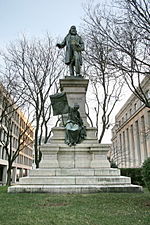Trinity Episcopal Church (Washington, D.C.)

Trinity Episcopal Church was an Episcopal church that stood from 1851 to 1936 on the northeast corner of 3rd and C Streets NW in the Judiciary Square neighborhood of Washington, D.C. Founded in 1827, the parish was home to prominent attendees including President John Quincy Adams, Senator Daniel Webster, and Francis Scott Key, who served as the church's senior warden. The first church building was located on 5th Street NW, across the street from District of Columbia City Hall, in what was then a fashionable area of the city. The parish grew and began planning a new church building. With financial assistance from William Wilson Corcoran, the parish bought the lot with which the church is best associated, and a cornerstone was laid in 1850. James Renwick Jr., who had recently won a competition to design the Smithsonian Institution Building, was selected to design Trinity's new sanctuary. The Gothic Revival building, topped with two towers, was completed in 1851. During the Civil War, the church was used as a military hospital for Union soldiers. In the decades after the war, Washingtonians began moving to more desirable areas of the city, and attendance at Trinity decreased. Despite renovations and the addition of a parish hall in the 1890s, the church continued to decline and grew deeper into debt. The local diocese took over the property after World War I, and the church became a social service outreach center. The property was sold in 1936, and after the church was stripped of valuable contents and building materials, it was demolished and replaced with a parking lot. The Frances Perkins Building, headquarters of the United States Department of Labor, now stands on the site.
Excerpt from the Wikipedia article Trinity Episcopal Church (Washington, D.C.) (License: CC BY-SA 3.0, Authors, Images).Trinity Episcopal Church (Washington, D.C.)
Constitution Avenue Northwest, Washington
Geographical coordinates (GPS) Address Nearby Places Show on map
Geographical coordinates (GPS)
| Latitude | Longitude |
|---|---|
| N 38.893377 ° | E -77.014946 ° |
Address
Frances Perkins Department of Labor Building
Constitution Avenue Northwest 200
20001 Washington
District of Columbia, United States
Open on Google Maps










